| Top Ten NYC Architecture | top ten New York churches | |||||||||||||||
| For a more complete list, see Church | ||||||||||||||||
| 1 | TRINITY CHURCH | |||||||||||||||
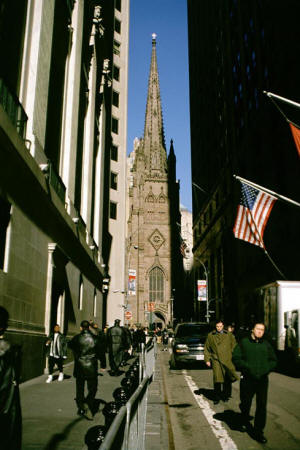 |
Trinity Church, at 74 Trinity Place in New York City, is a historic full service parish church in the Episcopal Diocese of New York. Trinity Church is located at the intersection of Broadway and Wall Street in downtown Manhattan. St. Paul's Chapel, part of the Parish of Trinity Church, is the oldest public building in continuous use in New York City. Trinity Episcopal Church in Fishkill, New York was started in 1756 with the missionary assistance of Trinity Church. Photo of Trinity Church and the schoolhouse of Trinity School (c. 17??). At the time of its completion, in 1846, its 281-foot spire and cross was the highest point in New York until being surpassed in 1890 by the New York World Building. On July 9, 1976, the church was visited by Queen Elizabeth II of the United Kingdom, and she was presented with a symbolic "back rent" of 279 peppercorns. Since 1993, Trinity church has been the location which the High School of Economics and Finance holds their senior graduation ceremonies. The school is located on Trinity Place (a few blocks away from the church). |
|||||||||||||||
| 2 | St. Paul's Chapel | |||||||||||||||
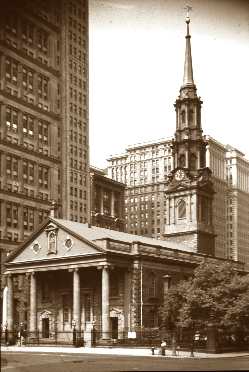 |
St. Paul's Chapel, at 209 Broadway, is an Episcopal chapel located on Church Street between Fulton and Vesey Streets, opposite the east side of the World Trade Center site in lower Manhattan in New York City. A chapel of the Parish of Trinity Church, St. Paul's was built on land granted by Queen Anne of Great Britain, and Andrew Gautier served as the master craftsman. Upon completion in 1766, it stood in a field some distance from the growing port city to the south. It was built as a "chapel-of-ease" for parishioners who lived far from the Mother Church. Inside, the chapel's simple elegant hall has the pale colors, flat ceiling and cut glass chandeliers reminiscent of contemporary domestic interiors. In contrast to the awe-inspiring interior of Trinity Church, this hall and its ample gallery were endowed with a cozy and comfortable character in order to encourage attendance. |
|||||||||||||||
| 3 | St. Patrick's Cathedral | |||||||||||||||
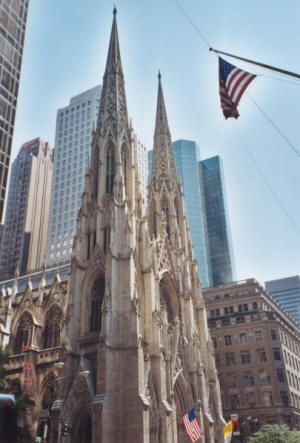 |
St. Patrick's Cathedral is the largest decorated Neo-Gothic-style Catholic cathedral in North America. It is the seat of the archbishop of the Roman Catholic Archdiocese of New York, and a parish church, located on Fifth Avenue between 50th and 51st streets in Manhattan. It faces Rockefeller Center. The Cathedral of New York's Catholic Archdiocese and seat of its Cardinal, in its early years this elaborate building served, among others, the working class, immigrant Catholic staff who were employed by the city's Episcopalian elite. The Cathedral's Gothic Revival design is based on French models. Somewhat generic in its form, it lacks the quaint flavor of Grace and Trinity Churches and the mysterious grandeur of St. John the Divine. A Lady Chapel, added to the Madison Avenue side of the Cathedral in 1906, is more impressive than the rest of the edifice. When construction began, the Cathedral was located on the outskirts of town in an area of slaughter houses and cattle yards. As construction progressed, the city advanced northwards to the area around St. Patrick's. Nevertheless, the site remained somewhat 'tainted' in the minds of 19th century New Yorkers. |
|||||||||||||||
| 4 | St. John the Divine | |||||||||||||||
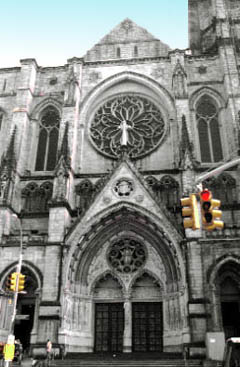 |
The Cathedral of St. John the Divine, officially the Cathedral Church of Saint John the Divine in the City and Diocese of New York, is the Cathedral of the Episcopal Diocese of New York. Located at 1047 Amsterdam Avenue New York, NY 10025 (between West 110th Street, which is also known as "Cathedral Parkway", and 113 Street) in Manhattan's Morningside Heights, the cathedral is claimed to be the largest cathedral and Anglican church and third largest Christian church in the world (although the title is disputed with Liverpool Anglican Cathedral). The cathedral, designed in 1888 and begun in 1892, has, in its history, undergone radical stylistic changes and the interruption of the two World Wars. It remains unfinished, with construction and restoration a continuing process. |
|||||||||||||||
| 5 | St. Bartholomew's Church | |||||||||||||||
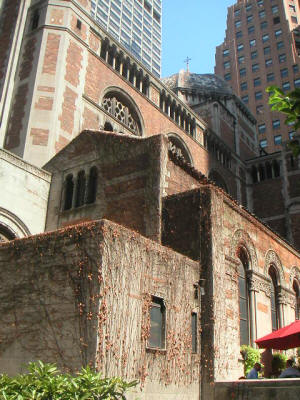 |
The foundation stone of Goodhue's original design, a vast, unified barrel-vaulted[5] space, without side aisles or chapels and with severely reduced transepts, was laid 1 May 1917[6] and the construction was sufficiently far along for the church to be consecrated in 1918; its design was altered during construction, after Goodhue's sudden, unexpected death in 1924, by his office associates, in partnership as Mayers, Murray and Philips; they were engaged in erecting the community house, continuing with the same materials, subtly variegated salmon and cream-colored bricks and creamy Indiana limestone; they designed the terrace that still provides the equivalent of a small square, surrounded by the cliff-like facades of Midtown commercial structures (illustration, upper right); in summer, supplied with umbrellas and tables, it becomes Café St. Bart's. They also inserted the "much discussed"[7] dome, tile-patterned on the exterior and with a polychrome Hispano-Moresque interior dome, which substituted for the spire that had been planned but never built.[8] Completed in 1930, the church contains stained-glass windows and mosaics by Hildreth Meiere, and a marble baptismal font by the Danish follower of Canova, Bertel Thorvaldsen. St. Bartholomew's, completed by 1930 at a cost of $5,400,000,[9] is one of the city's landmarks; for long of New York's wealthiest parishes, St. Bart's is known for its wide range of programs. It draws parishioners from all areas of New York City and its surroundings. |
|||||||||||||||
| 6 | Little Church Around the Corner | |||||||||||||||
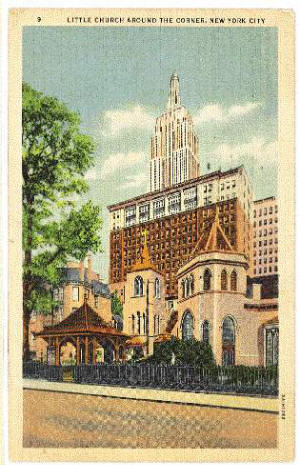 |
Located at 1 East 29th Street,in the Murray Hill District, the church is set back from the street behind a garden creating a facsimile of the English countryside in midtown Manhattan and has long been an oasis for New Yorkers of all faiths who relax in the garden, pray in the chapel or enjoy free weekday concerts in the main church. It has also been known as the "wedding church" because of the popularity of the church for weddings. The “Little Church Around the Corner,” was founded in 1848 “to embrace all races and classes.” Designed in the early English Neo-Gothic style and with its quaint English Garden retains a picturesque quality of a true English parish church, despite being in sight of the Empire State Building. The church also features numerous and eclectically designed side chapels and a 14th Century stained glass window. |
|||||||||||||||
| 7 | Marble Collegiate Church | |||||||||||||||
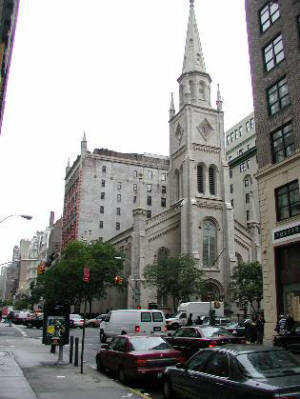 |
Marble Collegiate Church is a church of the Reformed Church in America located at Fifth Avenue and Twenty-Ninth Street in New York City. It is the oldest continuous Protestant congregation in the United States; It was founded in 1628 as the Collegiate Reformed Protestant Dutch Church, and was part of the Calvinist Dutch Reformed Church. Dr. Norman Vincent Peale was Pastor there for fifty years from the mid-1930s. The present Pastor is Dr. Arthur Caliandro. |
|||||||||||||||
| 8 | St. Jean Baptiste Church | |||||||||||||||
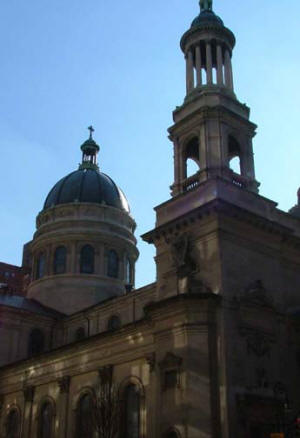 |
The construction of the present church building was due, in large part, to the contributions of Thomas Fortune Ryan and his wife. Ryan, a devout and wealthy man of unassuming ways, preferred St. Jean's to the large and showy parishes near his Fifth Avenue home, and the Blessed Sacrament Fathers served as his wife's private chaplains at the Ryan's country home in Suffern, New York. One day he arrived late for mass and found that there was standing room only. At the conclusion of the service, he approached the officiating priest and asked how much it would cost to build a new church. The priest answered, apparently off the top of his head, "$300,000." Ryan replied, "Get some plans and I will pay for it." The new church, completed in 1913, was designed by Nicholas Serracino in the Italian Baroque style, with a massive, freestanding Corinthian portico, twin bell towers, and a magnificent dome over the crossing of the nave and transepts. The total cost was close to $600,000, but both the patron and the parish were apparently quite satisfied with the result, as we still are today. |
|||||||||||||||
| 9 | Church of the Heavenly Rest | |||||||||||||||
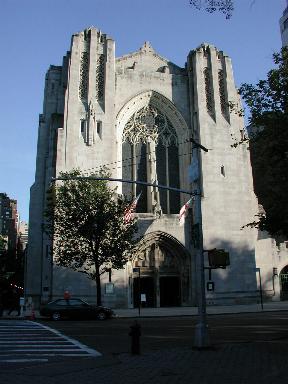 |
The church has always stood on Fifth Avenue, but originally much further south on E45th Street intersection. It was founded by a group of Civil War veterans in 1865. The present site on the eastern side of Central Park was acquired from Mrs Andrew Carnegie. The foundation stone was laid in 1926 and the church held its first service in 1929. The architect was Bertram Goodhue but he had died in 1924 so his plans were executed by Hardie Phillip (of Mayers, Murray & Phillip). It is a modernised Gothic style, almost Art Deco in some features, with a shimmering facade of limestone with large Geometric four light window above a double portal. Flanking this are two turrets, like miniature towers. |
|||||||||||||||
| 10 | First Church of Christ, Scientist | |||||||||||||||
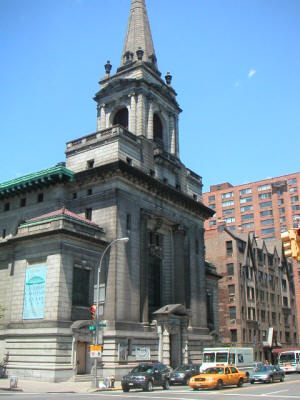 |
"Carrère & Hastings's evocation of the low church architecture of Georgian London and New England set the tone for many subsequent Christian Science churches throughout the northeast. Carrère & Hastings achieved a remarkable sense of solidity not only through the blocky composition, inspired by the English Mannerist architect Nicholas Hawksmoor, but also through the use of extremely large blocks of a white Concord granite, a stone so hard that it shattered mechanical saws and had to be cut by hand. Inside, the church was less distinctly English in feeling. A gallery wrapped around three sides of the auditorium, and barrel vaults sprang from piers which barely cleared the galleries, creating a powerfully encompassing effect. The room was largely undecorated, except for an elaborate organ case and rich Modern French plasterwork on the ceiling, which also contained roundels of concealed lighting. Supported above the auditorium arches were the church's offices, reading rooms and extensive Sunday school facilities. Clearly expressed on the exterior, their location reflected a unique solution to the problem of the parochial complex. Owen R. Washburn was correct in his assessment for the Architectural Record: "if we may not speak of a cathedral, in this case, we surely possess the metropolitan church." |
|||||||||||||||
| 11 | Judson Memorial Church | |||||||||||||||
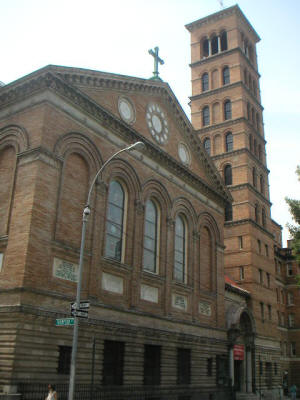 |
Judson Memorial Church is a particularly stately edifice, at the south side of Washington Square. The church building, designed by renowned architect Stanford White, and stained glass master John La Farge, features Italian Renaissance influences wedded to a basic Italianate form. It features notable examples of scagliola, a very convincing handcrafted imitation of marble made of highly polished pigmented plaster. Sculptor Augustus St. Gaudens designed a marble frieze in the baptistery. Overall, the exterior and shape of Judson Memorial is said to resemble Santa Maria, a basilica in Rome, while the entrance is said to be inspired by the Renaissance church San Alessandro, built in Lucca in 1480. The church is a national landmark. |
|||||||||||||||
| 12 | Riverside Church | |||||||||||||||
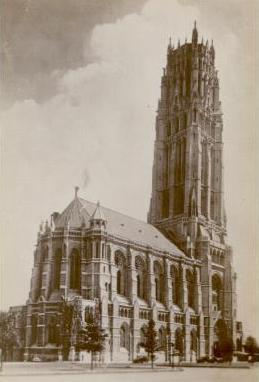 |
This Baptist Church was funded in large part by John D. Rockefeller Jr., whose wealthy family often used building endowments to cement their position in New York society and American politics. Built in the French Gothic style, the elaborate form of the church and its fine materials (such as stained glass) are at odds with the simple, pared-down style that normally characterizes Baptist ecclesiastical architecture. With an interior based on the Chartres Cathedral, the design shows off the Rockefellers' ability to straddle European and American building traditions. Modeled on Laon Cathedral, the church's bell tower is actually a 21-story steel-frame high-rise. Its enormous size all but overwhelms the nave beyond. |
|||||||||||||||
| 13 | St. Mark's in the Bowery Church | |||||||||||||||
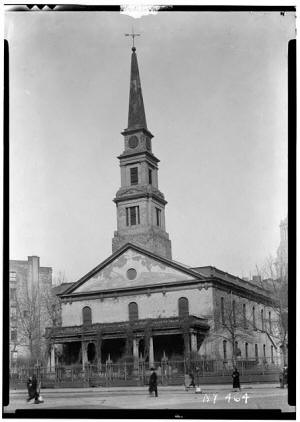 |
"The Bowery" was Dutch governor Peter Stuyvesant's farm, and his private chapel used to stand on this site--making this the oldest site of continuous worship in Manhattan. This church was erected 1795-99-- one of the few surviving 18th Century structures in Manhattan--with a Greek revival steeple added 1828 and an Italianate portico completing the structure in 1854. Originally a church of Manhattan's elite, St Marks became a progressive force in the neighborhood both socially and culturally. Supportive of immigrant, labor and civil rights, the church was a meetingplace for Black Panthers and Young Lords, and launched the first lesbian healthcare clinic. Poets like W.H. Auden (who was a parishoner), William Carlos Williams, Edna St. Vincent Millay, Amy Lowell, Carl Sandburg, Kahlil Gibran, Allen Ginsberg, Patti Smith and Jim Carroll have all read here; since 1966, the St Marks Poetry Project has organized poetry events. The Danspace project has featured dance legends like Isadora Duncan, Martha Graham and Merce Cunningham. Sam Shepherd's first two plays were produced here, and Andy Warhol screened his early films. |
|||||||||||||||
| 14 | SHRINE OF ST. ELIZABETH ANN BAYLEY SETON | |||||||||||||||
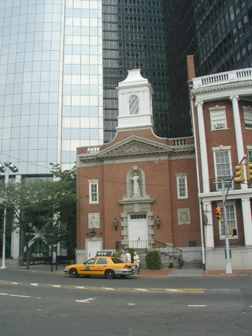 |
7 State Street (between Pearl and Whitehall Sts) 1793-1806, eastern portion architect unknown; the western half attributed to James McComb, Jr. architect Although a contemporary building, the shrine was designed in the Georgian Style to match the adjacent Watson House. This small chapel is dedicated to Elizabeth Seton, the founder of the Catholic order of Sisters of Charity, who was canonized in 1975. A close comparison of the Shrine with the Watson House reveals the material, technical and stylistic differences between the 18th century residence and its historicist 20th century neighbor. Once home of wealthy merchant James B. Watson, this typical Federal Style rowhouse is the only extant residence in this area. Like other merchants of 18th and early 19th century New York City, Watson chose to live near the river in order to have an unobstructed harbor view and to be in close proximity to his shipping interests. The eastern portion (1793) which follows the line of the street was executed by an unknown architect, while the curved western portion (1806) has been attributed to the sophisticated architect, John McComb Jr. Following the Civil War, the house was purchased by Irish immigrant Charlotte Grace O'Brien to serve as the Mission of Our Lady of the Rosary, a waystation for young immigrant girls. |
|||||||||||||||
| 15 | Abyssinian Baptist Church | |||||||||||||||
 |
Founded in 1808 at 40 Worth Street in lower Manhattan, Abyssinian Baptist Church served as a home base for both Reverend Adam Clayton Powell, Sr. and Jr. and played a major role in black history. The cavernous Gothic and Tudor (Neo-Gothic ) structure replete with imported stained-glass windows and an Italian marble pulpit was designed by Charles W. Bolton in 1923. Known as the largest and best known black congregation (weekly attendance numbers in the thousands) in the United States, Abyssinian Baptist has a superb choir and sixty-seven rank organ. |
|||||||||||||||